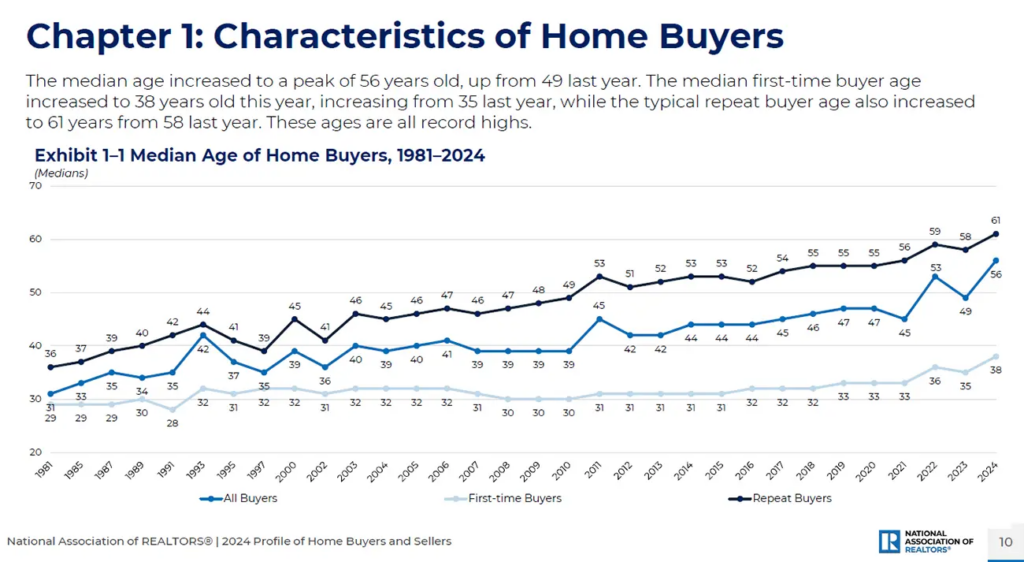According to the National Association of Realtors‘ (NAR) 2024 Profile of Home Buyers and Sellers, the market share of first-time homebuyers fell to a historic low of 24% (down from 32% last year), while the average age of home buyers reached all-time highs of 56 years (compared to 49 last year), 38 years for first-time buyers (compared to 35 last year), and 61 years for repeat buyers (compared to 58 last year).
“The U.S. housing market is split into two groups: first-time buyers struggling to enter the market and current homeowners buying with cash,” said Jessica Lautz, NAR Deputy Chief Economist and VP of Research. “First-time buyers face high home prices, high mortgage interest rates and limited inventory, making them a decade older with significantly higher incomes than previous generations of buyers. Meanwhile, current homeowners can more easily make housing trades using built-up housing equity for cash purchases or large down payments on dream homes.”
What Does the Typical U.S. Homebuyer Look Like?
- First-time buyers decreased to 24% of the market share (32% last year). This year now marks the lowest share since NAR began collecting the data in 1981.
- The median first-time buyer age increased to 38 years old this year from 35 last year, while the typical repeat buyer age also increased to 61 years from 58 last year.
- Some 62% of recent buyers were married couples, 20% were single females, 8% were single males, and 6% were unmarried couples.
- Roughly 73% of recent buyers did not have a child under the age of 18 in their home. This is the highest share recorded.
- Approximately 17% of homebuyers purchased a multigenerational home, for cost savings (36%), to take care of aging parents (25%), because of children or relatives over the age of 18 moving back home (21%, and children over the age of 18 who never left home (20%).
- Some 83% of buyers were white/Caucasian, roughly 7% were Black/African-American, 6% were Hispanic/Latino, 4% were Asian/Pacific Islander, and 3% identified as some other race.
- An estimated 88% of recent homebuyers identified as heterosexual, 3% as gay or lesbian, 2% as bisexual, 1% prefer to self-describe, and 6% preferred not to answer.
- Some 16% of recent homebuyers were veterans and 2% were active-duty service members.
- At 22%, the primary reason for purchasing a home was the desire to own a home of their own. For first-time buyers, this number jumps to 64%.

Buyer Demographics Vary Across U.S. Housing Markets
The median household income for the average homebuyer increased from $107,000 in 2022 to $108,800 in 2023. The median household income for first-time buyers was $97,000, increasing $26,000 over the previous two years and up from $95,900 the year before. The typical household income of repeat buyers increased to $114,300 from $111,700 the year before.
Married couples now make up 62% of all buyers, while the percentage of female buyers who are single has slightly climbed to 20%. On the other hand, the percentage of unmarried couples fell to 6% while the percentage of single men fell to 8%. Further, the proportion of unmarried female first-time purchasers increased by 5%.
Some 83% of recent homebuyers identified their ethnicity as White or Caucasian. Seven percent of recent buyers identified as Black/African American, 6% identified as Hispanic/Latino, 4% identified as Asian/Pacific Islander and 3% as some other ethnicity.
Roughly 73% of recent homebuyers did not have a child under the age of 18 in their home—the highest share recorded. Roughly 17% of homebuyers purchased a multigenerational home, the highest share in the data series. The top reasons cited were cost savings (36%), to take care of aging parents (25%), children over the age of 18 moving back home (21%), and children over the age of 18 who never left home (20%).
“As home buyers encounter an unaffordable housing market, many are choosing to double up as families,” Lautz said. “Cost savings are a major factor, with young adults returning home—or never leaving—due to prohibitive rental and home prices. Meanwhile, elderly parents and relatives are moving in with family members as home buyers reprioritize what matters most to them.”
Agents, Lenders Assist Purchasers During Complex Homebuying Process
With 86% of all purchasers using their services—the most of any information source—real estate agents were vital to the homebuying process. The most helpful source of information during the house hunt was the agents themselves.
A real estate agent or broker was involved in 88% of home purchases, indicating the ongoing significance of agents in the homebuying process. Almost 90% of purchasers said they were satisfied with their agent’s timeliness, understanding of the real estate market, honesty and integrity, and people skills. Some 80% homebuyers said they would refer their agency to others or use them again.
The median down payment for all homebuyers in 2024 was 18%, for first-time buyers it was 9%, and for repeat purchasers it was 23%. These were the biggest down payments for first-time buyers since 1997 and for repeat buyers since 2003. Though 25% used loans or presents from friends and family, 21% used financial assets, and an all-time high of 7% used inheritances, first-time buyers still mostly rely on savings (69%). A record 26 percent of homebuyers made cash payments.
The highest documented average age of home sellers was 63 years old. For the first time in four years, the percentage of married couples selling their homes increased to 69% from 65% the previous year. The desire to relocate closer to friends and family was the most common reason given by sellers for selling their house (23%), followed by the home being too small (12%), the home being too large (11%), and the community losing its appeal (10%).
“Family support systems are influencing buying and selling decisions,” Lautz said. “Being close to friends and family is the top reason to sell, while buying a home convenient to friends and family continues to grow in importance. Today’s buyers are less likely to be concerned with their work locations when purchasing, perhaps because of a higher share of older repeat buyers and remote work flexibility remaining a factor.”
Only 6% of sales were for-sale-by-owner, an all-time low, while 90% of sellers sold with the help of a real estate agent, up from 89% the previous year. The majority of sellers (87%) stated that they would refer their agent for future services either definitely (72%) or possibly (15%).
“Most home buyers and sellers find it valuable to use an agent who is a Realtor to help them maneuver through the complicated homebuying and selling processes, especially in a challenging housing market,” said NAR President Kevin Sears, Broker-Associate of Sears Real Estate/Lamacchia Realty in Springfield, MA. “Realtors provide critical knowledge and expertise that ensure a successful transaction.”
To read the full report, including more data, charts, and methodology, click here.






